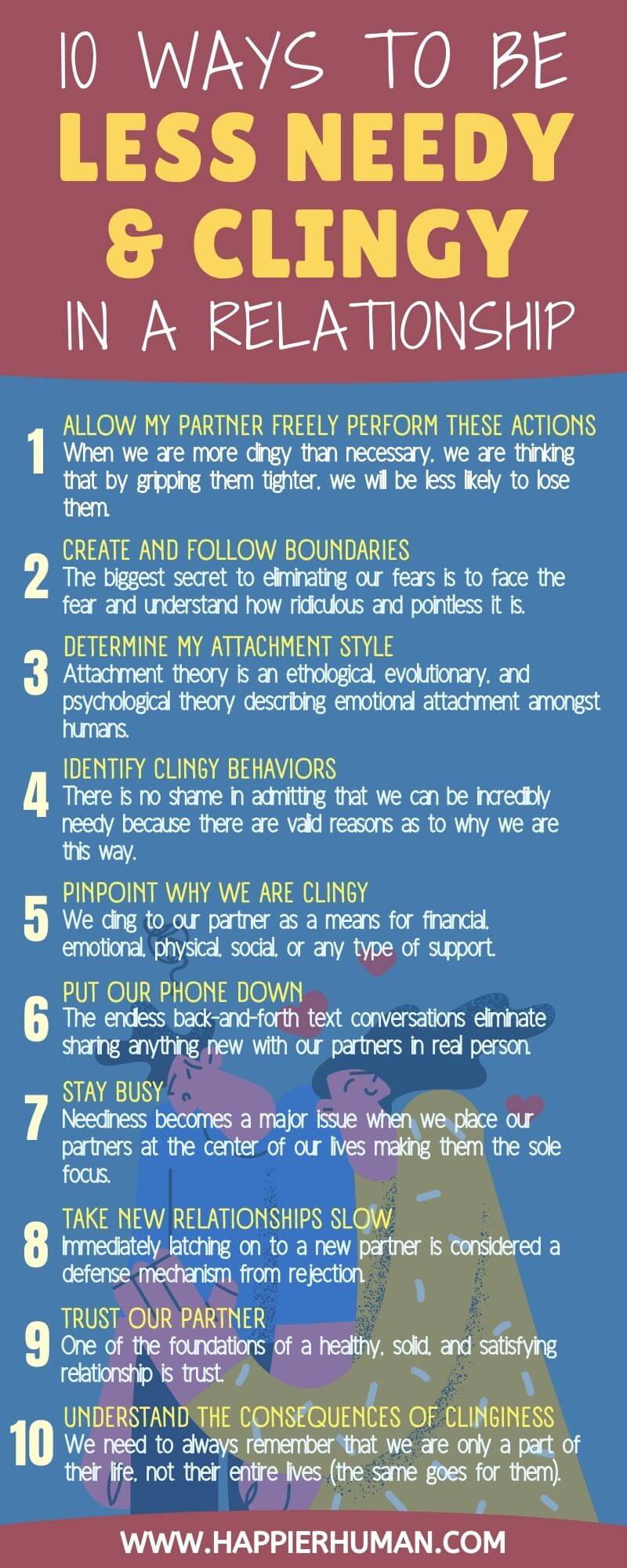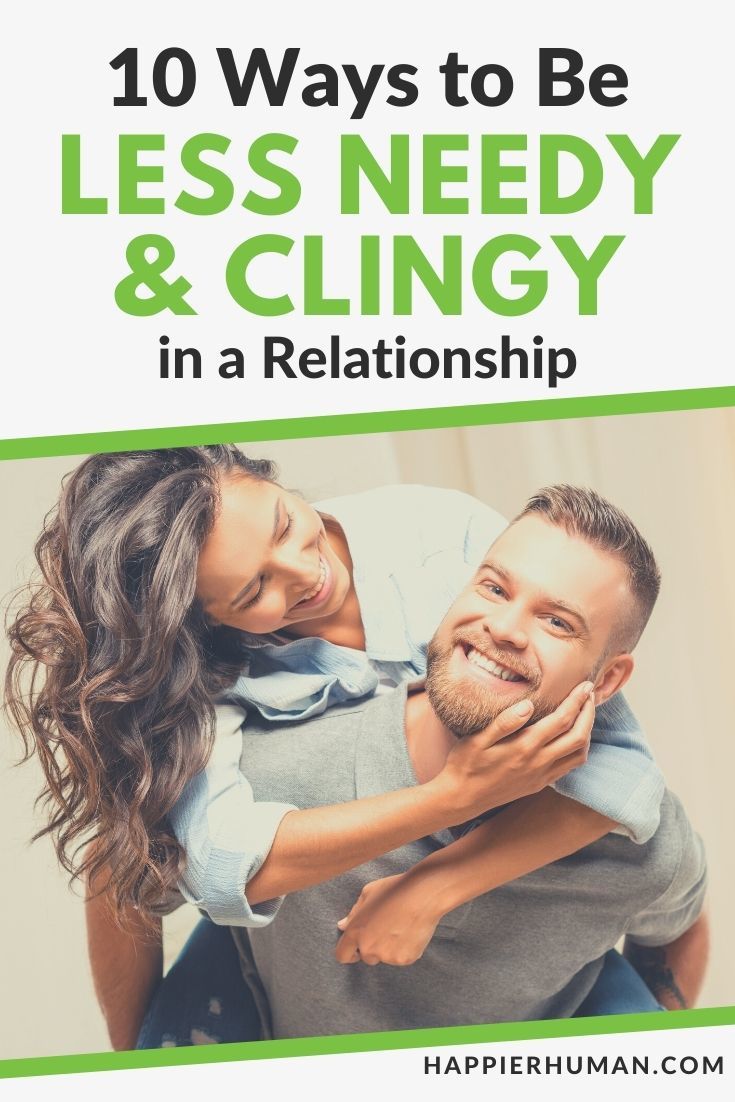There might be affiliate links on this page, which means we get a small commission of anything you buy. As an Amazon Associate we earn from qualifying purchases. Please do your own research before making any online purchase.
I think you will agree with me when I say that we are all clingy sometimes, especially at the beginning of a new relationship. When the connection is exciting and fresh, and we just cannot wait to see each other again.
While having clingy tendencies may have been acceptable in past relationships, being overly needy is a toxic dating habit. To avoid this, I am going to teach you 10 tips on how to be less needy so your relationships will be strong and long-lasting.
Let’s get to it.
What You Will Learn
- 1. Allow My Partner Freely Perform These Actions
- 2. Create and Follow Boundaries
- 3. Determine My Attachment Style
- 4. Identify Clingy Behaviors
- 5. Pinpoint Why We Are Clingy
- 6. Put Our Phone Down
- 7. Stay Busy
- 8. Take New Relationships Slow
- 9. Trust Our Partner
- 10. Understand the Consequences of Clinginess
- Final Thoughts on How to Be Less Needy and Clingy
1. Allow My Partner Freely Perform These Actions
When we are more clingy than necessary, we are thinking that by gripping them tighter, we will be less likely to lose them.
In this article, I want to wash that theory away and understand the infamous words of Richard Bach, “if you love someone, set them free. If they come back, they’re yours; if they don’t, they never were.” By “free”, that doesn’t mean ending the relationship. Free relates to trusting our partner enough for them to:
Understanding and following these actions is the best approach to inducing change.
2. Create and Follow Boundaries
The biggest secret to eliminating our fears is to face the fear and understand how ridiculous and pointless it is. We have to believe that our partner has a life away from us. Most clingy people have a difficult time coming to terms with this statement. We don’t want our significant other to see a movie, have dinner with friends, or have a few drinks at a bar without us. Unfortunately, the way the world works is we have to set up boundaries and give our partner space so they can still maintain the life they enjoyed before we came walking into the picture.
To do this, we must allow them to be someone else because they don’t exist just to be our boyfriend or girlfriend. We can create rules like:
Having small boundaries like these will benefit us in the end because it allows our better half to miss us and it acts as a reminder that we are not attached at the hip.
3. Determine My Attachment Style
Formulated by John Bowlby, attachment theory is an ethological, evolutionary, and psychological theory describing emotional attachment amongst humans. Psychologists have identified four attachment patterns adults should adopt when dealing with a needy individual, including:
Anxious Attachment
Those with the anxious attachment pattern need regular affection and reassurance from their partner. They have difficulty being alone or single because of loneliness.
Avoidant Attachment
The avoidant attachment style is comprised of dismissive-avoidant and fearful-avoidant. Dismissive-avoidant is one who avoids displaying feelings, can act narcissistically, does not prioritize romantic relationships, and won’t get too close to their partner. Those with a fearful-avoidant style are typically fearful of being left or hurt by their partner which can ultimately lead to the demise of the relationship.
Secure Attachment
Secure attachment involves those who are comfortable display affection and interest. They are also comfortable being alone at great lengths.
If I’m overly needy or clingy in a relationship, then I probably have the anxious attachment style. Luckily, our attachment style can evolve with some effort. Psychologists have postulated that our attachment style relates to the level of positive and negative self-image and positive and negative image of our partner-in-crime.

Therefore, if I’m the anxious style, I can foster a healthy self-image and create healthy boundaries. The best route is to find a passion, become good at it, and make the focal point of our lives instead of our partner.
4. Identify Clingy Behaviors
Recognizing how neediness can be unhealthy is the best approach to taking responsibility. There is no shame in admitting that we can be incredibly needy because there are valid reasons as to why we are this way. Great relationships are rare and valuable so being clingy may indicate that we are attempting to be caring for our partner but it’s over the top. Note the following clingy habits so we can unlearn them.
Once we identify what needs to change, it is an easier path ahead.
5. Pinpoint Why We Are Clingy
One of the most common reasons we can be overly needy is we do not have the resources to live a standard lifestyle and rely on our partner to provide said resources. In these situations, we cling to our partner as a means for financial, emotional, physical, social, or any type of support. We need to understand that challenges occur to the best of us that may drive this type of behavior. Perhaps I am a full-time student who doesn’t have a moment to work or I have a temporary physical condition preventing me from working.
These situations are temporary; at some point, I will graduate resulting in a higher earning power, or eventually, I will return to good health and thus full-time employment. Having this understanding will bring calm and peace. Once I have reached a level of understanding, I must review the financial relationship with my partner to come to a compromise. A good way to do this is with a weekly or monthly budget with funds being transferred to each of our bank accounts for independence. That way, I am not asking them for money daily causing my partner to feel uncomfortable.
6. Put Our Phone Down
This could be the toughest point for some readers! Believe it or not, in the past, it was so much easier to not be needy and clingy. Landline phone calls were not accessible wherever we went, and social media didn’t exist. Email was available but not in the palm of our hands. Instead, we would catch up with our beau or belle in person or on the phone, in the evenings.
Clingy behaviors, such as constantly checking our phones for text replies, is a 21st-century habit. Instead of allowing our partners to enjoy downtime or to focus on work, we seek attention by calling, texting, or bombarding our partners with emails, photos, or article links. While we all like the occasional message or interesting photo or article, enough is enough! The endless back-and-forth text conversations eliminate sharing anything new with our partners in real person.
Sometimes we also get the urge to check their social media feed to see if they are doing things or having fun without us. It’s tough to believe that just 30-years ago or so, couples went to work separately in the morning and didn’t contact one another until returning home at night! Shocker!
At this time and for millennia before, few mobile phones existed and workplaces forbid personal calls during regular business hours, except for emergencies. That means for 8-10 hours per day, partners did not speak, see, chat, or interact with each other at all. The result was they got a break from each other and actually had a classic dinner conversation beginning with “how was your day?” Yep, everything in movies and on tv shows was accurate!
The good news for us is we can determine if the frequency of keeping in touch with our partner is excessive. First, I choose a random 24-hour period and track all times I have proactively contacted my better half. This means that I am not reacting to a message with an emoji or brief comment. To properly track this, I consider voice, text, forwarding articles, sending images, and posting links to their wall as communication.

During these 24 hours, I also track the number of times my partner was proactively contacting me. When reviewing the proactive contact numbers for my 24-hour period, it is critical to note the difference between the two numbers. I am trying to determine how much more I am contacting my significant other than they are trying to get in touch with me.
If the difference is greater than five, then I need to dial it back. For instance, if I am proactively contacting my partner 25 times during 24 hours and she is in touch with me 16 times then the difference is nine times. This could certainly be viewed as needy or clingy, even though I am seeing it as showing that I miss them and am trying to be loving. This is not healthy.
Therefore, the next time we have an urge to contact our partner, it is always best to give it to a friend, so we aren’t tempted to use it or just hide away our phone. The more we minimize our time in front of the mobile screen, the more we can pay attention to the activities and people around us. This tip will also help us better maintain our friendships since we can be more actively listening and engaging instead of having our heads stuck in the phone.
7. Stay Busy
Neediness becomes a major issue when we place our partners at the center of our lives making them the sole focus. Therefore, instead of expecting our boyfriend or girlfriend to entertain us, I like to fill my day with various enjoyable activities. Kickboxing and other forms of fitness are a great stress release that consumes a decent amount of my time in the evenings. Of course, during the day, I am focused on working so the evenings are the only time I can spend with my partner. When I start a new relationship, I still maintain my fitness routine and add in cooking, reading, and writing. This allows me to spend time with my new partner without being overbearing.
Here are some other helpful and time-consuming activities:
Find new hobbies
When first entering a new relationship, we sometimes neglect our passions and pursue new and fun activities. When working against neediness, new interests and hobbies always help temporarily shift our minds away from our partner.
Meditate
Like exercise, meditation can do a tremendous amount for our overall health. By allowing our body and mind to more from our partner, we can become more grounded and refreshed.

Spend more time with loved ones
There were countless friends and family who were a major part of my life before meeting my significant other and they will be there for me if we ever break-up. If those relationships have diminished, reconnecting with our siblings, parents, and friends purposefully is a great way to spend time with loved ones and away from our partner for a bit. We must never invite our family or friends to hang out then cancel the plans if our new partner wants to go on a date. We have to draw the line and cannot cut out some of the most important people in our lives.
Travel alone or with friends
Whether I am organizing a trip abroad with my friends or am going to explore another local city, traveling without my partner often reinforces my sense of self which improves my confidence. The old saying, “absence makes the heart grow fonder,” is spot on.
8. Take New Relationships Slow
Immediately latching on to a new partner is considered a defense mechanism from rejection. In this instance, we are so worried our partner will break off the relationship, we become overly aggressive to ensure they will stick around. However, when we move relationships too fast, it often scares off our partner.
The best approach is to just relax, go slow, and take it easy. I like to look at it as an opportunity to get to know a new human being instead of jumping the gun and automatically demanding all their time. It’s difficult to find a balance because we don’t want to fall to the other end of the spectrum where we appear aloof and don't care at all. I always try to find the balance in the middle when entering a new relationship.
9. Trust Our Partner
One of the foundations of a healthy, solid, and satisfying relationship is trust. In other words, we must believe that our partner is in our corner and has our best interest at heart, and vice-versa. Understanding that they are just as committed to ensuring this relationship is successful and that they will do everything in their power to keep us safe and happy, will help us move toward a more trustful nature.

Generally, the more we trust each other, the less anxious we are about the relationship. In some instances, our partner has said or done something that makes us lose faith. Also, we may have learned through personal experience that trusting others is a poor choice. Whichever the case, we have trust issues in a relationship and the situation must be addressed together. So how do we do that?
Simple – in-person conversation. That means we are keeping the texting novels and even lengthy phone calls out of it. By using the old fashioned form of communication, we can discuss why either of us feels too needy or clingy, and what steps we can take for elimination. It could also be as simple as needing reassurance from our partner that we trust each other.
There should be two goals when we have this conversation: (1) making our partner aware of how their words or actions have caused us to lose trust and (2) creating a plan to avoid these trust issues in the future.
10. Understand the Consequences of Clinginess
A common myth is that neediness and clinginess will make our love grow closer. The thought is that our better half will see how much we care and love for them so they will reciprocate it, thus returning the same amount of love. This myth shouldn’t motivate our intentions because clinginess is counterproductive in relationships.
If our partner becomes complacent because they know we will always drop everything to accommodate them then they will stop effort into growing the relationship which leads to them relishing their power over us. The more likely result is our partner will feel pressured because we expect them to fulfill our emotional needs. Naturally, our partners will feel suffocated at the thought they are our only source of happiness and life. The result will be them feeling trapped and attempting to escape.
We need to always remember that we are only a part of their life, not their entire lives (the same goes for them). That means having goals, dreams, and plans of our own is important to self-growth and development but also making the relationships easier for our partners since they don’t feel the need to coddle us constantly.
Final Thoughts on How to Be Less Needy and Clingy
Learning and understanding how to be less needy and clingy will help make for longer-lasting and fruitful relationships. Our partner will be happier, we will be happier, and it will make seeing each other more exciting and productive. By following the above ten tips, we can start the road to being less clingy today!


